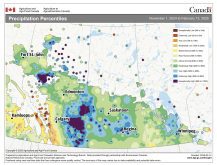This cattle market information is selected from the weekly report from Canfax, a division of the Canadian Cattlemen’s Association. More market information, analysis and statistics are available by becoming a Canfax subscriber by calling 403-275-5110 or at www.canfax.ca.
Fed market rises
The fed market usually puts in its summer low at this time of year, but instead, the western Canadian fed market continues to grind higher, setting new annual price highs. Both Alberta and Ontario fed prices are averaging more than $180 per hundredweight and are sitting $20-$23 per cwt. higher than a year ago.
Read Also

Huge Black Sea flax crop to provide stiff competition
Russia and Kazakhstan harvested huge flax crops and will be providing stiff competition in China and the EU.
Based on the latest Canfax Trends report, heavier weight feeders saw slightly positive feeding margins in September following 13 consecutive months of losses. Besides short keep steers, all other classes of cattle were sold with negative margins on the cash market.
On average, calves that were placed in December 2021 and sold in September were negative $170 per head. Alberta 850-pound feeders placed in March and sold in September on average were negative $99 per head.
Last week, dressed sales were reported from $302-$304 per cwt. delivered. Cattle traded last week were scheduled for the week of Oct. 17 delivery. Though cattle are being scheduled one month out, there have been numerous reports they are being picked up ahead of schedule.
Over the past four weeks western Canadian fed slaughter has been down slightly, averaging 45,290 head per week compared to 46,753 head per week last year.
In Ontario, dressed sales were reported from $303-$306 per cwt. delivered, steady to $3 lower than the previous week.
For the first half of September, Canadian steer carcass weights are record large, averaging 942 lb. Carcass weights usually trend larger into fall, peaking in early November.
In the United States, ddressed sales in the northern feeding states ranged from US$224-$230 per cwt. and live sales were reported from $142-$144. Live sales in Texas and Kansas were at $142 per cwt., $1 stronger.
U.S. beef exports for July were four percent larger than a year ago, with larger volumes being shipped to Japan and China. Year-to-date beef exports are up seven percent.
Cow prices ease
Non-fed prices traded mixed last week with slaughter cow prices easing $2-$3 per cwt. lower while butcher bull prices rebounded almost $5.50 per cwt. higher than the previous week to average $128.36 per cwt. Dressed cow bids saw softer buying interest to around $205-$210 per cwt. delivered. D2s averaged $104.25 and D3s averaged $90.36 per cwt.
Slaughter bull exports to the U.S. for the week ending Sept. 3 were five percent larger than a year ago at 1,228 head, and year-to-date volumes are six percent larger, totalling 27,008 head. Strong U.S. utility cow prices and a softer Canadian dollar will limit Canadian slaughter cow downside, and good trim and grind demand should continue on both sides of the border.
After beginning the year relatively weak, Alberta cull cows have seen significant price gains, up 49 percent from January to August. Alberta D2 cow prices were five to 12 percent below the five-year average in January and February. From March to May, monthly prices averaged eight percent higher than the five-year average.
Cull cow prices have historically weakened from the May high to the November low. This year, Alberta cow prices have continued to strengthen after levelling off briefly in June at $104 per cwt. In July, cows were 23 percent higher than last year and 19 percent higher than the five-year average at $109 per cwt.
High auction numbers
Alberta auction volumes were significantly larger last week due to a special forward calf sale and reduced pasture conditions. Calf prices firmed higher for all weights on improved quality and larger lot sizes. Strong demand was observed for benchmark steer calves from 500-700 lb. with prices up $6-$8 per cwt.
Large feeders heavier than 800 lb. traded unevenly with steer prices steady. Similar weight heifers slipped more than $2 per cwt. lower.
Total Alberta auction volumes were 243 percent larger than the previous week at 92,154 head and were 127 percent larger than the same week last year. Weekly auction volumes larger than 70,000 head are typically not seen until late October to early November. Year to date, feeder exports are 109 percent larger than a year ago, totalling 159,453 head.
U.S. cut-outs lower
In U.S. beef trade, cutouts ended the week lower, following seasonal trends. The Choice cutout was down 2.2 percent from last week to US$252.34 per cwt., and the Select cutout was down 2.6 percent to $229.95.
















